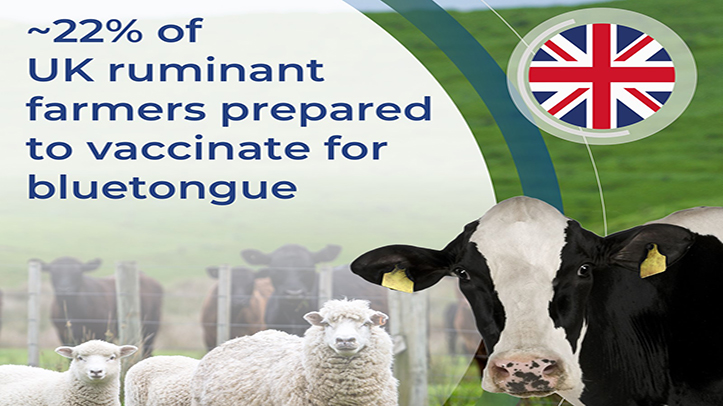Dairy, beef and sheep farmers across the UK and Ireland have revealed their likelihood of bluetongue vaccine uptake.
Transmitted by biting midges, bluetongue has spread from mainland Europe to the UK. Now present in Kent, Norfolk, Suffolk, Essex, Yorkshire and Lincolnshire, the virus serotype BTV-3 is causing concern due to its impact on animal health and the potential for trade restrictions.
These recent outbreaks have led to strict regulations aimed at preventing its spread. As of September 4, Defra is also permitting use of three BTV-3 vaccines.
Throughout August, Kynetec asked its panel of UK farmers, how much of a concern is bluetongue and if a bluetongue vaccine was available in the UK and Ireland, how likely would you be to use it?
Gemma Norman, research director, animal health & nutrition, at Kynetec, said: “14% of dairy farmers across England, Wales, Scotland and Northern Ireland were concerned about bluetongue and 22% would use a vaccine. Dairy farmers in the Republic of Ireland have little to no concern regarding bluetongue compared to those in the UK.
“Just 10% of UK beef farmers are concerned about bluetongue, however 22% would still use a vaccine. As with dairying, beef farmers in the Republic of Ireland have little to no concern in respect to bluetongue.
“11% of sheep farmers in the UK expressed concern around bluetongue and 23% would vaccinate for it. Again, sheep farmers in the Republic of Ireland have little to no concern around bluetongue.”
Ms Norman continued: “Warmer, wetter conditions and flooding are causing headaches for farmers, not least because it’s resulting in an increased prevalence of midges and midge-borne diseases, such as bluetongue and Schmallenberg.
“Having worked in beef, sheep and dairying myself, I understand the pressures of yet another challenge to the health and welfare of both livestock and farm businesses. It’s interesting to see that bluetongue is on farmer’s radars, and we hope that the data gleaned from our famer panels, such as this, can help the wider animal health industry to understand farmer views.”


